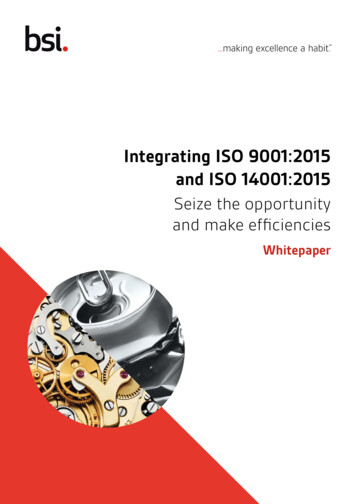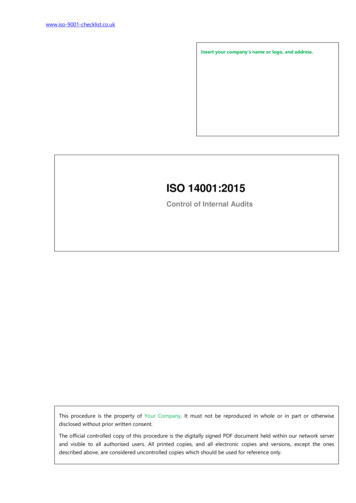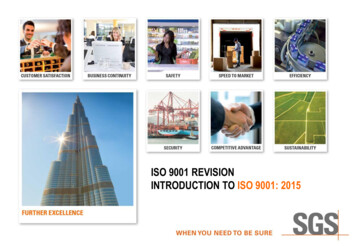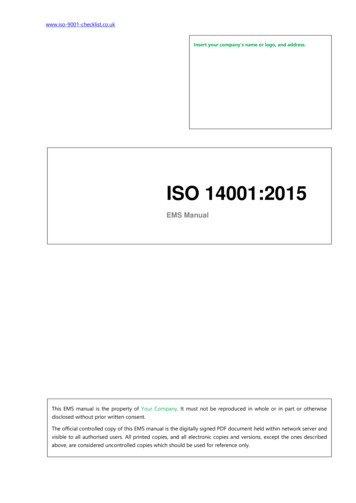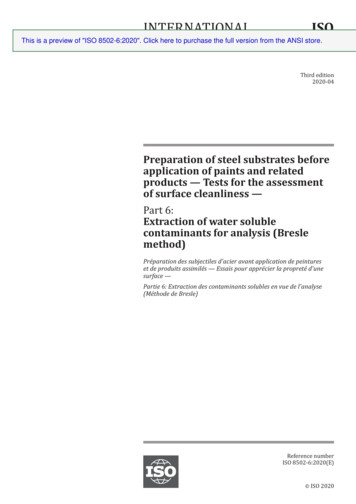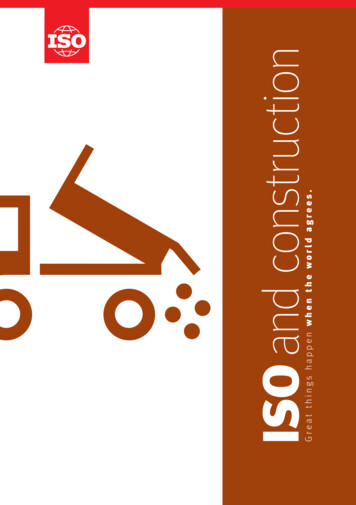
Transcription
Great things happen when the world agrees.ISO and construction
We are ISO,the International Organizationfor Standardization162*members21 700*International StandardsWe are an independent,non-governmental organization.100We are a global networkof national standards bodieswith one member per country.247new standards each month*technical committeesOur job is to make InternationalStandards.We are coordinated by a CentralSecretariat in Geneva, Switzerland.We are not for profit : selling ourstandards allows us to financetheir development in a neutralenvironment, to maintain themand to make new ones.ISO provides a platform fordeveloping practical tools throughcommon understanding andcooperation with all stakeholders.ίσοςNotice that our acronymdoesn’t match our name ?It’s not meant to.“ ISO ” is derived fromthe Greek word isos (equal),so that it’s the same inall languages.* October 2017
Why do we need ISO standardsfor construction ?The world’s rapid population growth and rampant urbanization have brought anincreasing need for a high-quality, safe and sustainable built environment. In theworld of building and construction, ISO standards help codify international bestpractice and technical requirements to ensure buildings and other structures(known as civil engineering works) are safe and fit for purpose.Updated on a regular basis to account for climate, demographic and socialchanges, ISO’s standards for construction are developed with input from allstakeholders involved, including architects, designers, engineers, contractors,owners, product manufacturers, regulators, policy makers and consumers.4
Who benefits from ISO standardsfor construction ?IndustryISO standards help to make the constructionindustry more effective and efficient byestablishing internationally agreed designand manufacturing specifications and processes.They cover virtually every part and process ofthe construction project, from the soil it standson to the roof.ISO standards also provide a platform for newtechnologies and innovations that help theindustry respond to local and global challengesrelated to demographic evolution, naturaldisasters, climate change and more.RegulatorsRegulators can rely on best-practice test methods,processes and harmonized terminology thatare constantly reviewed and improved, as atechnical basis for regulation and policy relatedto construction.ConsumersISO standards give consumers confidence in theconstruction industry, providing reassurance thatbuildings and related structures such as bridgesare built to internationally agreed safety andquality standards. These help ensure that thebuildings people live, work and study in are safe,comfortable and function as intended.5
What standards does ISO havefor construction ?Of the more than 21 700* International Standards and related documents,ISO has over 1 100 related to buildings and construction, with many morein development. These cover :StructuresMasonryBuilding materialsand productsInformation managementin constructionEnergy performanceand sustainabilityHeating, coolingand lightingFire safety andfire fightingLifts andescalatorsConcreteand cementDesign life, durability andservice life planningTimber6
Who develops ISO standards ?ISO standards are developed by groups ofexperts within technical committees (TCs).TCs are made up of representatives fromindustry, non-governmental organizations,governments and other stakeholders whoare put forward by ISO’s members. EachTC deals with a different subject, such asbuildings and civil engineering works orspecific construction materials like cementor timber, often in close collaborationwith other relevant international orintergovernmental organizations. Asan example, ISO/TC 59, Buildings andcivil engineering works, through itssubcommittees and working groups, haspublished over 110 International Standardson aspects of quality and performance inthe built environment. Visit our WebsiteISO.org to find out more about thestandards developed in a particular sectorby searching for the work of the relevanttechnical committee.7
StructuresEnsuring all the components of structuresare strong enough to withstand appropriateloads and everything fits together as itshould is the objective of a number of ISOstandards for construction. By establishingdefined specifications and test methods,they help ensure structures are designedand built to agreed levels of quality. ISO/TC 98, Bases for design of structures,lays down the basic requirements forthe design of structures. With standardsfocusing especially on terminology andsymbols, loads and forces, it ensuresconstructions are built to last and canwithstand outside forces such as extremeweather events and natural disasters. ISO/TC 167, Steel and aluminium structures,develops standards that specifyrequirements for the structural use ofsteel and aluminium alloys in the design,fabrication and erection of buildings andcivil engineering works. Its scope of workincludes materials, structural componentsand connections. ISO/TC 165, Timber structures,deals with the strength and loadrequirements of structural timber, whilegeotechnical analysis (interactionsbetween soil and structure) is the focus ofISO/TC 182, Geotechnics.8
Building materials and productsBeing able to count on reliable, quality materials is essential forthe construction of safe and robust buildings. ISO has more than100 standards related to the raw materials used in construction, suchas concrete, cement, timber and glass. These include standards onterminology, testing procedures and the assessment of safety levels.We also have over 500 standards on building products, such asdoors and windows, wood-based panels, floor coverings, ceramictiles and plastic pipes and fittings. These not only determine thecorrect dimensions and specifications to ensure products aremanufactured to agreed quality levels, but also define test methodsfor assessing product safety and resistance to things like crushing orchemicals, so that they do not fail or deteriorate prematurely.9
Energy performance and sustainabilityFrom insulation to energy-using products, improving the energy performanceof buildings can make a significant contribution to climate-related targets. Asa result, building regulations increasingly require energy-efficient designs andmeasures are put in place to help improve overall performance. ISO/TC 163, Thermal performance and energy use in the built environment,has more than 130 standards providing guidelines and methods for thecalculation of energy consumption in buildings, covering areas such asheating, lighting, ventilation and so forth.ISO’s energy standards portfolio includes the recently published seriesISO 52000, Energy performance of buildings – Overarching EPB assessment,which defines methods to help architects, engineers and regulators assessthe overall energy performance of new and existing buildings in a holistic way. ISO/TC 205, Building environment design,has a range of standards defining methods and processes for the design ofnew buildings and retrofit of existing buildings, to create acceptable indoorenvironments and practicable energy conservation and efficiency.In addition, we produce standards for measuring the carbon emissionsof buildings and others structures, including : ISO 21930, Sustainability in buildings and civil engineering works – Core rulesfor environmental product declarations of construction products and services,which establishes good practices for making environmental claims andcommunications in the construction sector.10
Fire safety and fire fightingFires cause destruction and devastation, costing the lives and livelihoodsof people. With the increased density of housing, protecting against firesand detecting fire risks have never been more important. ISO/TC 21, Equipment for fire protection and fire fighting,develops standards covering fire protection and fire-fighting apparatusand equipment, including fire extinguishers and fire and smokedetectors. ISO/TC 92, Fire safety,develops standards for assessing fire risks to life and property andmitigating such risks by determining the behaviour of constructionmaterials and building structures. ISO 7240, Fire detection and alarm systems,defines the specifications of fire detection and alarm systemequipment used in and around buildings – including their testingand performance – in order to ensure they function effectively.11
Information managementin constructionSince most construction works are projectbased, having documentation that is clearlyunderstood by all stakeholders is essentialto ensure each project is realized in a costeffective manner. Building information models(BIM) are shared digital representations of thephysical and functional characteristics of anybuilt object (including buildings, bridges androads) and form a reliable basis for decisionmaking. They also help protect against the lossof valuable information between stages andprocesses. ISO/TC 59/SC 13, Organization of informationabout construction works,develops standards that define the commonterms of reference and terminology used inBIMs, as well as requirements for the digitalexchange of documentation and data.Examples include : ISO 16757-1, Data structures for electronicproduct catalogues for building services –Part 1 : Concepts, architecture and model ISO/TS 12911, Framework for buildinginformation modelling (BIM) guidance12
13
Lifts and escalatorsRising urbanization and denser populations mean buildings across the worldare getting taller. Efficient lifts and escalators are thus essential to cope withthe increased loads and access needs and must be operable in times ofdisaster, such as fire, to evacuate high-rise structures. ISO/TC 178, Lifts, escalators and moving walks,has over 50 standards, either published or in development, for all kindsof lifts. These cover requirements for everything from planning andinstallation to energy performance and safety.One prominent example is : ISO/TS 18870, Lifts (elevators) – Requirements for liftsused to assist in building evacuation14
Design life, durability and service life planning ISO/TC 59/SC 14, Design life,develops standards that offer a methodology and guidance on howto plan the service life of buildings, including predicting costs andthe frequency of maintenance and repairs over their life cycle. TheISO 15686 series on service life planning deals with a wide range ofsubjects in this area, such as performance audits and reviews, lifecycle assessment and maintenance and life-cycle costing.An example is : ISO 15686-5, Buildings and constructed assets – Service life planning –Part 5 : Life-cycle costing,which helps track the cost performance over an asset’s lifespan.15
ISO standards improve safety,sustainability and durabilityin construction.16
Buildingsand civilengineeringworksTimberISO/TC 218Doors andwindowsISO/TC 162ISO/TC 59Energy useISO/TC 163ISO/TC 205Glassin buildingISO/TC 160Fire safetyFloorcoveringsISO/TC 92ISO/TC 21ISO/TC 219ISO/TC 189Ceramic tilesISO/TC 178Lifts,escalatorsand movingwalksISO/TC 182ISO/TC 221Foundationsand soil17
18
More information ?@ISO Websitewww.iso.orgISO Website section : “ Standards in action ”www.iso.org/standards-in-actionISOfocus googleplusISO videoswww.iso.org/youtubeFollow us on Twitterwww.iso.org/twitterJoin us on Facebookwww.iso.org/facebookJoin us on GooglePluswww.iso.org/gplus19
InternationalOrganizationfor StandardizationISO Central SecretariatChemin de Blandonnet 8CP 4011214 Vernier, GenevaSwitzerlandiso.org ISO, 2017All rights reservedISBN 978-92-67-10779-0The symbol on the cover comes from theInternational Standard ISO 7000, Graphicalsymbols for use on equipment – Registeredsymbols. It serves to identify the control thatopens the flap located in the rear of the truck bed.Available on our Online Browsing Platform at :gotoi.so/isosymbols.
world of building and construction, ISO standards help codify international best practice and technical requirements to ensure buildings and other structures (known as civil engineering works) are safe and fit for purpose. Updated on a regular basis to account for climate, demographic and socialFile Size: 1MB

